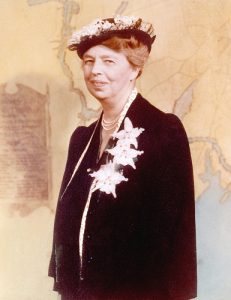 October 11 marks the birthday of the woman who spent more time in the White House as first lady than any before or since. At her birth, Eleanor Roosevelt seemed destined for a life lived mostly on the periphery of the political dynasty she was born into. A series of childhood tragedies changed her trajectory, and Eleanor went on to not only redefine the role of first lady, but also to become a political force in her own right.
October 11 marks the birthday of the woman who spent more time in the White House as first lady than any before or since. At her birth, Eleanor Roosevelt seemed destined for a life lived mostly on the periphery of the political dynasty she was born into. A series of childhood tragedies changed her trajectory, and Eleanor went on to not only redefine the role of first lady, but also to become a political force in her own right.
Born in 1884 to socialite parents, Eleanor was orphaned by the age of 9. She attended Marie Souvestres’s all-girl’s finishing school in England. Souvestre’s teaching methods encouraged students to think independently and express themselves. The influence of this education is visible in the social justice work Eleanor pursued as an adult. Blanche Wiesen Cooke’s “Eleanor Roosevelt: Volume One, 1884-1933” documents in depth these influential early years of Eleanor’s life.
After her education, Eleanor returned to the states and became acquainted with her distant cousin, Franklin. Romance blossomed, and the two married in 1905, with Eleanor given away by her Uncle Teddy. From the beginning their relationship was fraught with difficulties. Franklin was not faithful, famously finding love with Eleanor’s social secretary, Lucy Mercer. This was painful for Eleanor, who contemplated leaving him, but it’s speculated that she may have also found romance outside of their marriage. Hazel Rowley’s “Franklin and Eleanor: An Extraordinary Marriage” explores their unconventional relationship, why they stayed together and how it ultimately benefited them in their own personal pursuits.
Their marriage grew into a political force to be reckoned with after a life-changing battle with polio threatened Franklin’s political career. Eleanor helped Franklin keep in touch with the political world during his recovery through her own involvement in the Democratic party. She learned how to successfully navigate the political world and pursue those social causes that were most important to her. As first lady, Eleanor truly found her political voice. “No Ordinary Time” by Doris Kearns Goodwin provides insight into how World War II affected the homefront and shaped Eleanor’s role as first lady as she worked to help the nation’s poor and disenfranchised.
Even after she was no longer first lady, Eleanor managed to have a huge influence on humanitarian causes, with a focus on racial and social justice. Marc Peyser’s “Hissing Cousins: The Untold Story of Eleanor Roosevelt and Alice Roosevelt Longworth” provides an interesting look at Eleanor’s political pursuits by contrasting them with her cousin, Alice Roosevelt’s. Alice, the oldest child of Uncle Theodore, was in many was Eleanor’s equal. She was quite intelligent and is famous for her biting wit (though Eleanor also had a way with words). Alice was also interested in politics, just like her cousin, but their viewpoints and interests varied wildly. Peyser’s book offers a fascinating look at the strikingly different ways both women affected politics in Washington and how that shaped their own relationship.


